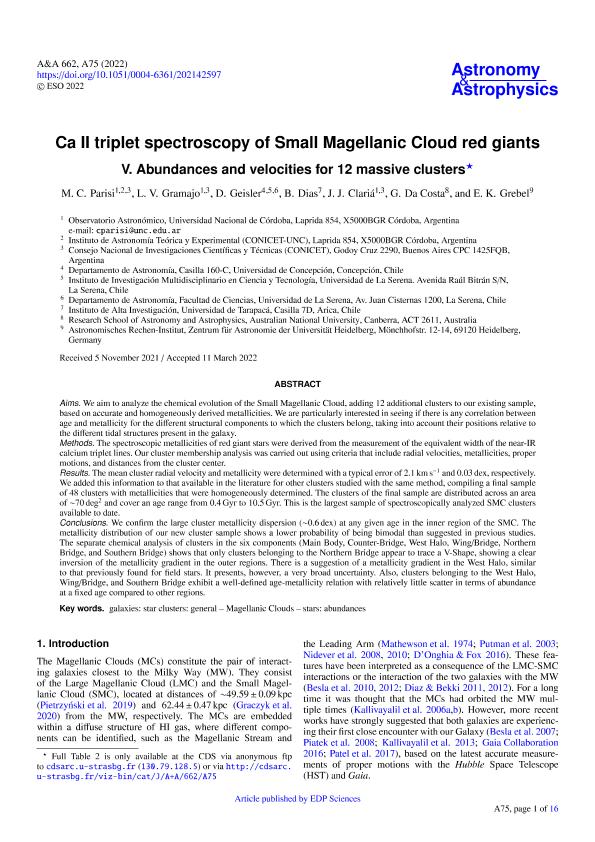Artículo
Ca II triplet spectroscopy of Small Magellanic Cloud red giants: V. Abundances and velocities for 12 massive clusters
Parisi, Maria Celeste ; Gramajo, Luciana Veronica
; Gramajo, Luciana Veronica ; Geisler, D.; Dias, B.; Clariá, Juan José
; Geisler, D.; Dias, B.; Clariá, Juan José ; Da Costa, G.; Grebel, E. K.
; Da Costa, G.; Grebel, E. K.
 ; Gramajo, Luciana Veronica
; Gramajo, Luciana Veronica ; Geisler, D.; Dias, B.; Clariá, Juan José
; Geisler, D.; Dias, B.; Clariá, Juan José ; Da Costa, G.; Grebel, E. K.
; Da Costa, G.; Grebel, E. K.
Fecha de publicación:
06/2022
Editorial:
EDP Sciences
Revista:
Astronomy and Astrophysics
ISSN:
0004-6361
Idioma:
Inglés
Tipo de recurso:
Artículo publicado
Clasificación temática:
Resumen
Aims. We aim to analyze the chemical evolution of the Small Magellanic Cloud, adding 12 additional clusters to our existing sample, based on accurate and homogeneously derived metallicities. We are particularly interested in seeing if there is any correlation between age and metallicity for the different structural components to which the clusters belong, taking into account their positions relative to the different tidal structures present in the galaxy. Methods. The spectroscopic metallicities of red giant stars were derived from the measurement of the equivalent width of the near-IR calcium triplet lines. Our cluster membership analysis was carried out using criteria that include radial velocities, metallicities, proper motions, and distances from the cluster center. Results. The mean cluster radial velocity and metallicity were determined with a typical error of 2.1 km s-1 and 0.03 dex, respectively. We added this information to that available in the literature for other clusters studied with the same method, compiling a final sample of 48 clusters with metallicities that were homogeneously determined. The clusters of the final sample are distributed across an area of ∼ 70 deg2 and cover an age range from 0.4 Gyr to 10.5 Gyr. This is the largest sample of spectroscopically analyzed SMC clusters available to date. Conclusions. We confirm the large cluster metallicity dispersion (∼ 0.6 dex) at any given age in the inner region of the SMC. The metallicity distribution of our new cluster sample shows a lower probability of being bimodal than suggested in previous studies. The separate chemical analysis of clusters in the six components (Main Body, Counter-Bridge, West Halo, Wing/Bridge, Northern Bridge, and Southern Bridge) shows that only clusters belonging to the Northern Bridge appear to trace a V-Shape, showing a clear inversion of the metallicity gradient in the outer regions. There is a suggestion of a metallicity gradient in the West Halo, similar to that previously found for field stars. It presents, however, a very broad uncertainty. Also, clusters belonging to the West Halo, Wing/Bridge, and Southern Bridge exhibit a well-defined age-metallicity relation with relatively little scatter in terms of abundance at a fixed age compared to other regions.
Palabras clave:
GALAXIES: STAR CLUSTERS: GENERAL
,
MAGELLANIC CLOUDS
,
STARS: ABUNDANCES
Archivos asociados
Licencia
Identificadores
Colecciones
Articulos(CCT - CORDOBA)
Articulos de CTRO.CIENTIFICO TECNOL.CONICET - CORDOBA
Articulos de CTRO.CIENTIFICO TECNOL.CONICET - CORDOBA
Articulos(IATE)
Articulos de INST.DE ASTRONOMIA TEORICA Y EXPERIMENTAL
Articulos de INST.DE ASTRONOMIA TEORICA Y EXPERIMENTAL
Citación
Parisi, Maria Celeste; Gramajo, Luciana Veronica; Geisler, D.; Dias, B.; Clariá, Juan José; et al.; Ca II triplet spectroscopy of Small Magellanic Cloud red giants: V. Abundances and velocities for 12 massive clusters; EDP Sciences; Astronomy and Astrophysics; 662; 6-2022; 1-16
Compartir
Altmétricas



